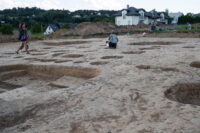 The remains of a ceramic vessel with a human face and horns have been discovered at a Neolithic site in the village of Biskupice near Wieliczka, southern Poland. It was unearthed inside a dwelling in a settlement of the Linear Pottery culture that dates back 7,000 years.
The remains of a ceramic vessel with a human face and horns have been discovered at a Neolithic site in the village of Biskupice near Wieliczka, southern Poland. It was unearthed inside a dwelling in a settlement of the Linear Pottery culture that dates back 7,000 years.
The Linear Pottery peoples originated in the Danube area and followed the Vistula into what is today Poland. They were some of the first farmers on Polish soil. Archaeologists have known there was a Neolithic settlement in Biskupice for decades, but excavations only began recently due to planned construction in the area. The excavation has expanded in scope and has revealed the remains of rectangular longhouses that are characteristic of Linear Pottery culture settlements from this period.
 Archaeologists found a series of oblong pits on both sides of one of the longhouses. They contained pottery and flint remains, including a section of a bowl decorated with a human face. On the forehead are two bumps that look like horns. The fragment is four inches wide, but the curvature is broad so the intact bowl would have been significantly larger. Vessels with similar ornamentation have been found in Slovakia and Hungary, but they didn’t have any horns. This is the first example ever discovered in Poland.
Archaeologists found a series of oblong pits on both sides of one of the longhouses. They contained pottery and flint remains, including a section of a bowl decorated with a human face. On the forehead are two bumps that look like horns. The fragment is four inches wide, but the curvature is broad so the intact bowl would have been significantly larger. Vessels with similar ornamentation have been found in Slovakia and Hungary, but they didn’t have any horns. This is the first example ever discovered in Poland.
 So far more than 3,000 artifacts have been discovered in the oval pits at the site. Besides the face bowl, objects include stone cores used to shape flint tools, scrape leather, cut wood and butcher bones. There are also obsidian cores which must have been imported as the black volcanic glass is not native to Poland.
So far more than 3,000 artifacts have been discovered in the oval pits at the site. Besides the face bowl, objects include stone cores used to shape flint tools, scrape leather, cut wood and butcher bones. There are also obsidian cores which must have been imported as the black volcanic glass is not native to Poland.
This year’s excavations are over, but will hopefully resume next year. Meanwhile, researchers will study the objects recovered and their contexts. Botanists will study the plant remains found next to the artifacts which are extremely important as Neolithic plant matter is rarely collected and can shed unique light on the dawn of agriculture.